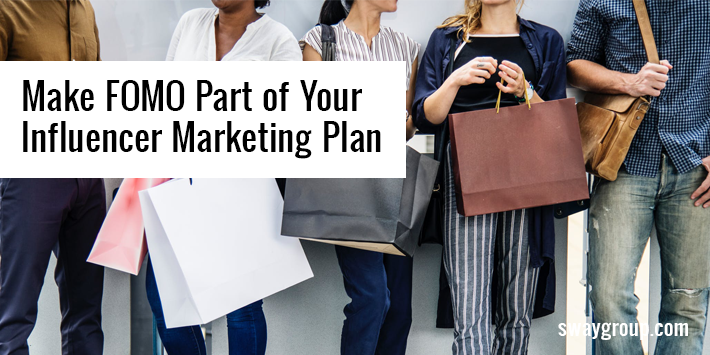FOMO is a feeling everyone has related to at one point or another. So much so that the term is an official word in the Oxford English Dictionary, being defined as: fear of missing out: anxiety that an exciting or interesting event may currently be happening elsewhere, often aroused by posts seen on a social media website.
For many, the pursuit of avoiding FOMO functions as a motivation to take action even if it may not be the most logical decision. For instance, we have all had those occasions where we are way too busy and overwhelmed, yet we still attend the friend group hang-out because we don’t want to miss out on the fun. In addition to experiences, FOMO can also apply to products and services. Undoubtedly, many of us have purchased something solely because we’ve heard others raving about it, and we want to join in on the conversation.
Smart marketers can use FOMO to their advantage to motivate buying behavior. The most efficient way to foster FOMO is through influencer marketing. When your brand’s product or service is being talked about and suggested by a consumer’s favorite influencer, the consumer is far more likely to make a purchase.

Strategically developing FOMO
There are a number of ways that brands can use FOMO to their advantage — in fact, Faith Popcorn, founder and CEO of consulting firm BrainReserve, boils one three-part strategy down to “Foster, Fight, or Flip.”
Let’s look at some examples of each:
- Fostering FOMO: Boosting buzz around events or purchases in order to encourage the feeling of not wanting to miss out on the action or conversation (weighted blankets, Coachella, cult-appeal skincare products, Jordans).
- Fighting FOMO: Providing a curation service so that consumers feel like they have access to the latest, hottest items and content (beauty and style subscription boxes, limited-time offers, exclusive deals, event livestreams, discovery algorithms on TikTok, Spotify, Amazon, Netflix, etc).
- Flipping FOMO: Turning away from the FOMO trend altogether with options to unplug or avoid popular activities or distractions (REI’s anti-Black Friday #OptOutside campaign, downtime-focused apps like Calm).
Influencers can be an integral part of your FOMO efforts by driving demand or providing a feeling of being in the know. As credible and often aspirational sources, influencers bring an emotional element to your product or service. Their audiences trust their recommendations and can feel a heightened sense of interest or desire for a shared experience. GenZ especially resonates more with this authentic messaging compared to traditional advertising forms.
Why FOMO Works
After all, if your favorite beauty influencer is generating a lot of buzz by raving about the benefits of a new face cream in her latest GRWM video, you’re likely to want to try the cream for yourself — and also spark some buzz of your own by sharing it with your own followers.
You can also use FOMO in influencer marketing to prompt consumer action by creating a campaign based around scarcity or exclusivity. When stock is restricted, or there’s only a certain number of signups available, or a time-limited discount, consumers feel a sense of urgency which creates demand and drives purchasing decisions. Invitation-only websites, memberships, pop-up shops, and content providers all prompt curiosity and a desire to be part of an exclusive group.
Working with Influencers to Foster FOMO
When working with influencers to foster FOMO, it is essential to collaborate effectively and create campaigns that resonate with your target audience. Partnering with a full-service agency like Sway Group can make a substantial difference in the success of your campaign. Sway Group’s expert team can help you identify the right influencers whose values align with your brand and whose audience fits your target demographic. They can assist with negotiations, content creation, and campaign execution, ensuring a seamless collaboration. They can also guide you in creating authentic, relatable content that genuinely connects with the audience, leading to a natural sense of FOMO. Utilizing limited-time offers, exclusive previews, or user-generated content, Sway Group can help foster urgency and community engagement. Additionally, they can provide the invaluable service of tracking and analyzing key metrics to measure the success of your campaign, and provide insights for optimizing future efforts.
Ready to execute your influencer marketing campaign?
Whether you’re chasing FOMO with your marketing efforts or turning it on its head, it’s a great tactic for generating traffic and prompting engagement. Talk to Sway today to learn more about how we can design a high-performance campaign for your business with our network of talented influencers!
About Sway Group:
Sway Group is a full-service influencer marketing agency that can boost your brand presence and drive real engagement to your ideal market. Our experts can help your brand through every step of the process, guaranteeing results.
